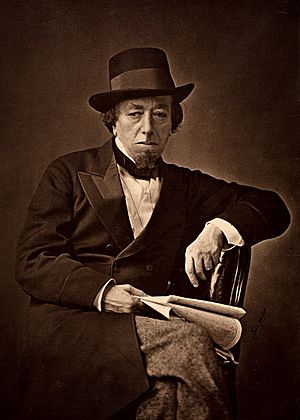Lies, damned lies, and statistics facts for kids

The saying "Lies, damned lies, and statistics" is a famous phrase. It talks about how numbers and facts (statistics) can be used to make weak arguments sound strong. People also use this phrase when they don't trust the numbers someone else uses to prove their point. It's a well-known way to question how statistics are sometimes used.
This phrase became popular in the United States thanks to the writer Mark Twain. He said that the British Prime Minister Benjamin Disraeli first used it. However, this phrase isn't found in anything Disraeli wrote. The first times it appeared in print were actually years after he died. Many other people have been suggested as the phrase's true creator. Sometimes, people even think Mark Twain himself made it up.
Contents
History of the Famous Phrase
How Mark Twain Made it Popular
Mark Twain helped make this saying very well-known. He wrote about it in his book Chapters from My Autobiography in 1907. He said, "Numbers often trick me, especially when I'm the one arranging them." He then added that the saying attributed to Disraeli often felt true: "There are three kinds of lies: lies, damned lies, and statistics."
Who Else Might Have Said It?
Some people, like Colin White, think the phrase might have started with François Magendie. He was a French doctor (physiologist) who lived from 1783 to 1855. Magendie was against using blood-letting to treat fevers. When he saw statistics he thought were made up, he said something like: "The way truth is changed, from simple lying to outright false statements, reaches its highest point with statistics." Colin White believes many people would have liked to create this phrase. Because of this, its true origin is now a bit of a mystery.
Many others have also been linked to the phrase. These include the English journalist Henry Labouchère and the British politician Leonard H. Courtney. Courtney used the phrase in 1895. Two years later, he became the president of the Royal Statistical Society. He said a "wise statesman" had used the phrase, but it's not clear who he meant. Even Arthur Wellesley, 1st Duke of Wellington has been mentioned.
Early Mentions in Print
The phrase was often quoted in 1895. But there's an example from 1894 that says: "His less enthusiastic neighbor thinks of the proverbial kinds of falsehoods, 'lies, damned lies, and statistics'." This shows it was already known.
A book called A Dictionary of English Folklore says the earliest similar phrase found in print was in a British newspaper. It was in the National Observer on June 13, 1891. A letter talked about "three kinds of falsehood: the first is a 'fib,' the second is a downright lie, and the third and most aggravated is statistics." Later that year, in October 1891, someone asked in Notes and Queries who first said the phrase. This shows it was already commonly used back then.
Different Versions of the Saying
The American Dialect Society has records showing other early uses.
- Sir Charles Wentworth Dilke was reported in October 1891 to have used the phrase. He said that false statements could be put into three groups: "fibs, lies, and statistics."
- In 1892, Robert Giffen noted that the phrase was a twist on an older joke. That joke said there were three types of unreliable witnesses: "a liar, a damned liar, and an expert." Giffen said this joke was changed to criticize statistics. He explained: "There are three degrees of comparison, it is said, in lying. There are lies, there are outrageous lies, and there are statistics."
- An even older version of the "liars and experts" joke appeared in Nature magazine in 1885. It mentioned a lawyer who grouped witnesses into "simple liars, damned liars, and experts." This lawyer meant that experts, by how they emphasized things or avoided direct answers, could be worse than simple liars.
- In 1885, a group called the X Club also talked about "the three classes of witnesses—liars, d—d liars, and experts."
How the Phrase is Used Today
The phrase "Lies, damned lies, and statistics" has been used in the titles of many popular books. These books often explore how numbers can be used to mislead people.
- Lies, Damned Lies, and Statistics: The Manipulation of Public Opinion in America (1976) by Michael Wheeler.
- Quotes, Damned Quotes ..... some of them to do with statistics (1985) by John Bibby. This book tried to figure out the history of the saying.
- Damned Lies and Statistics: Untangling Numbers from the Media, Politicians, and Activists (2001) by Joel Best.
- Lies, Damned Lies, and Drug War Statistics (2014) by Matthew B. Robinson & Renee G. Scherlen.
The famous essay The Median Isn't the Message by Stephen Jay Gould starts with this quote. Gould explains how a statistic about his cancer was misleading. He was told that his type of cancer had a "median survival time of eight months." He showed how this number didn't tell the whole story about his chances.

